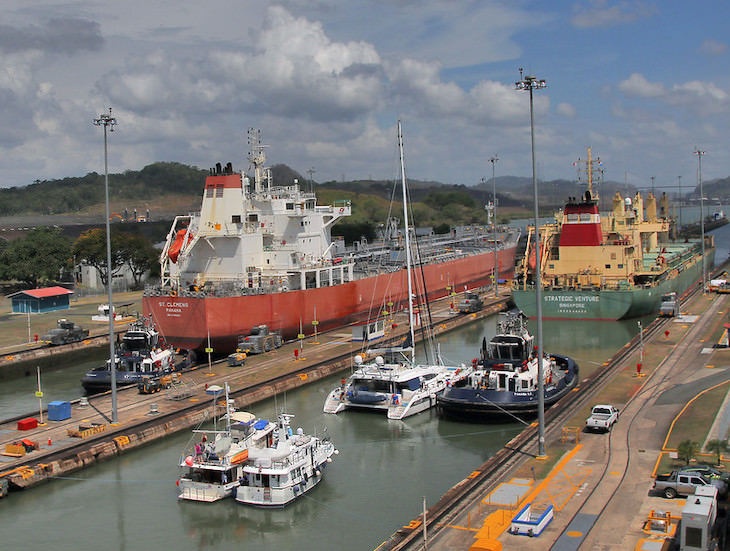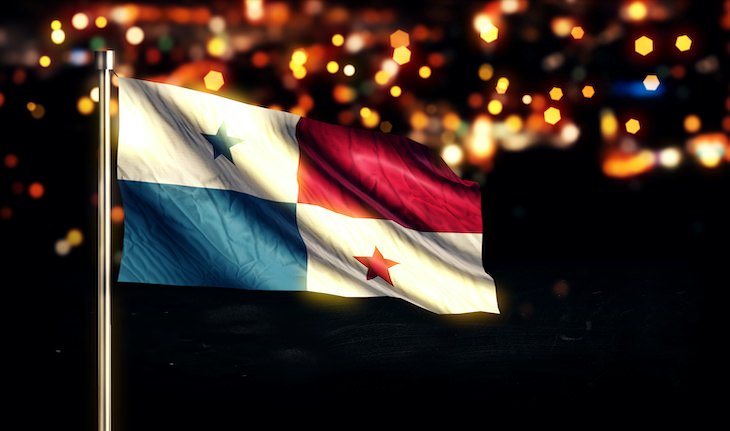
Although the Panama Canal is only 40 percent the length of the Suez Canal, its engineering posed a much greater challenge, and the fact it operates today is one of the biggest achievements of the 20th century. Officially opened on August 15, 1914, the Panama Canal is a waterway across the Isthmus of Panama, connecting the Atlantic Ocean to the Pacific Ocean. The 50-mile-long (80 km) passage allows ships to avoid the hazardous and lengthy Cape Horn route, as well as the even less popular route through the Arctic Archipelago, by using a system of locks to lift ships 85 feet (26 m) above sea level.
So why was making this infrastructure possible such a long and tumultuous project? Read on to learn the fascinating and intricate history of the Panama Canal.

In 1513, Spanish explorer Vasco Nunez de Balboa became the first European to discover that the Isthmus of Panama was just a slim bridge separating the Atlantic and Pacific oceans. This discovery triggered a search for a natural waterway linking the two vast oceans, but for several decades no such passage was found. In 1543 Charles V, the then Holy Roman Emperor ordered a survey to determine whether it was possible to build one. Much to his disappointment, the surveyors eventually concluded that the construction of a canal was impossible.

In the following centuries, various nations had toyed with the idea but no serious attempt was made to develop the Panama canal until the 1880s. In 1881, a French company headed by Ferdinand de Lesseps, a former diplomat who developed Egypt’s Suez Canal, broke ground and began actual work to build a crossing. The project was plagued by poor planning, engineering problems, and tropical diseases that killed thousands of workers. De Lesseps's original plan was to build a canal at sea level, like the Suez Canal, eliminating the need for locks, but the geography and geology of the area proved it was an impossible endeavor.
De Lesseps himself had visited the site only a few times prior to the beginning of construction, and only during the dry season which lasts just four months of the year. As a result, his team was severely unprepared for the challenges lying ahead - the torrents of the rainy season, the dense jungle around that contained venomous snakes, insects, and spiders, along with yellow fever, malaria, and other tropical diseases. By 1884 the death rate was over 200 laborers per month, and it was clear that canal locks were needed. The frustrated team then hired Gustave Eiffel, who designed the famous tower in Paris that bears his name, to create a lock system for the canal. However, in 1889 De Lesspes’s company filed for bankruptcy, having sunk 260 million USD into the project.
The canal venture’s collapse caused a major scandal in France. De Lesseps and his son Charles, along with Eiffel and several other company executives were indicted for fraud and mismanagement. In 1893, the men were found guilty, sentenced to prison, and fined, although the sentences were later overturned. De Lesseps died in 1894. That same year, a new French company was formed to take over the building project, however, the new firm soon abandoned the endeavor as well.

Image Source: Flickr
Throughout the 1800s, the US had a great interest in creating a Trans-American canal for economic and military reasons but considered Nicaragua a more feasible location than Panama. However, that view was shifted thanks to a little convincing from a man named Philippe-Jean Bunau-Varilla, a French engineer who had been involved in both of France’s canal projects. In the late 1890s, Bunau-Varilla began lobbying American lawmakers to buy the French canal assets in Panama.
He eventually convinced a number of them that Nicaragua had dangerous volcanoes, making Panama the safer choice. Eventually, the US would shell out some $375 million to build the canal (which included a $10 million payment to Panama as a condition of the 1903 treaty, and $40 million to buy the French assets).
Surprisingly, the Nicaraguan option is still on the table today, over 100 years later. In 2013, a Chinese company announced it had struck a $40 billion deal with the Nicaraguan government for the rights to construct such a waterway.
Related: The Most Amazingly Engineered Structures

Congress authorized the purchase of the former French assets in 1902. However, an unexpected challenge arose, when Colombia, which Panama was then a part of, refused to ratify an agreement allowing the United States to build a canal. Bunau-Varilla and the US government wouldn't take no for an answer, and in response, support was given to Panamanian rebels who wanted to win independence from Colombia. With the help of US troops and funds, the rebels overthrew the Colombian government, and Panama declared independence on November 3, 1903.

The earlier French attempts to build the canal cost the lives of more than 20,000 workers. The American efforts fared a little better, and yet, some 5,600 workers died due to accident or disease between 1904 and 1913.
Many of the earlier deaths had been caused by yellow fever and malaria, diseases that the medical community at the time believed were caused by bad air and dirty conditions. By the early 20th century, there was a better understanding of sanitation, in particular the need to drain mosquito breeding grounds, which significantly reduced the spread of diseases during construction.
Related: The Humble Beginnings of Famous Structures!

Every year, between 13 and 14 thousand ships traverse the canal. On average, it takes between 8 and 10 hours to pass through. American ships make use of the canal the most, followed by those from China, Chile, Japan, Colombia, and South Korea. Every vessel that crosses the canal must pay a toll based on its size and the cargo volume. For large ships, this can run about $450,000. The smallest fee was paid by Richard Halliburton who paid 36 cents to swim the canal. All in all, some $1.8 million are annually collected in tolls.
Another interesting fact is that ship captains aren’t allowed to transit the canal on their own; instead, a specially-trained canal pilot takes navigational control of each vessel to guide it through the waterway.
In 1977, President Jimmy Carter and General Omar Torrijos of Panama signed treaties that transferred control of the canal to Panama in 1999 but gave the United States the right to use military force to defend the waterway against any threat to its neutrality.

Image Source: Flickr
As successful as the canal had been it is unable to handle modern-day mega-ships. In 2007, work began to expand the canal system in order to accommodate Post-Panamax vessels - this is the name given to ships that exceed the canal’s dimensions. The works were completed in June 2016.
This expansion program consisted of new larger locks and widening and deepening of existing channels. The expansion has allowed many modern ships to use the canal, although some super-sized cargo vessels, such as Maersk's Triple E Class Ships will still be excluded.
Share this incredible history with family and friends